11 Best AI No Code Tools [2023]
The complexity of AI and the need for specialized knowledge is often a huge barrier for many businesses and individuals.
But thanks to the rise of no code and AI business tools, the power of AI is now accessible to everyone, regardless of their technical expertise.
Whether you’re a small business owner looking to leverage AI for your operations, an entrepreneur with a big idea, or a professional wanting to incorporate AI into your workflow, these AI no-code tools offer a user-friendly and efficient way to tap into the power of AI.
- , Software

1. Softr
Softr makes website building a breeze with their no-code platform. Easily create web apps, portals, and internal tools without coding. Softr integrates nicely with top data sources like Airtable and Google Sheets too.
Now here’s where it gets really exciting – Softr recently unveiled Softr AI, which uses OpenAI to completely transform website creation. Users can effortlessly generate engaging content and images with just a few AI prompts. Game changer!
But Softr AI goes beyond site building. It enables creating micro SaaS platforms right from your site. Visitors can generate custom text or images with AI. This is possible thanks to Softr’s AI dynamic blocks that can be added anywhere.
For those familiar with Wix or Squarespace, Softr feels intuitive with its block-based design. Except now you’ve got AI power! Whether you need AI-created text or images, Softr AI delivers.
Softr also focuses on user friendliness and fast adaptation. In minutes, you can have a functioning site leveraging AI for stock photos, compelling copy, and more. It opens up endless possibilities for AI website development.
In summary, Softr AI is truly revolutionary. It makes creating any type of website or micro SaaS platform a breeze, even for non-coders. If you can imagine it, Softr AI provides the tools and AI muscle to make it a reality.
2. Bubble

Bubble.io offers a powerful no-code platform for building a wide range of web applications without needing coding expertise. With Bubble, anyone can turn their ideas into functioning software like SaaS products, marketplaces, and CRMs.
You see, Bubble is like Shopify, where Shopify helps you build online stores without any code, and Bubble helps you build software without any code.
You can literally build fully functional apps like Airbnb or Uber with just drag-and-drop features, so it’s basically democratized the ability for non-technical people like myself to build software tools.
What sets Bubble apart from other no-code tools is its ability to handle complex backend logic for custom applications. You don’t just create frontend interfaces and workflows in Bubble – you can build fully functional web apps from start to finish.
For entrepreneurs and small teams, Bubble provides game-changing capabilities. It combines no-code convenience with the power of AI through integrations with platforms like OpenAI. This means Bubble users can tap into state-of-the-art AI to enhance their applications.
Bubble also fosters a supportive community through its active user forum. Members help one another solve problems and create new possibilities with the platform.
As you can see, Bubble is one of the best no code AI tools for startups that has the potential to speed up software development and make it more accessible.
3. Make.com

While Bubble is used for the design, the user management, and actually billing your customers, Make.com is an AI workflow automation tool that lets you integrate any software you use in your business.
Let’s say that you use a system that includes project management, CRM, and customer support tools. You may struggle with syncing information across these different tools, which can lead to communication gaps, delayed projects, and unhappy clients.
So instead of having to go to all of these different software tools as individual steps or tabs, With Make, you can actually combine different features and put them all into one platform.
You can create a central dashboard or a one-stop shop where you can see your tasks, your sales leads, and your customer support tickets from all of these different softwares all in one unified view with absolutely no code.
4. Obviously.ai
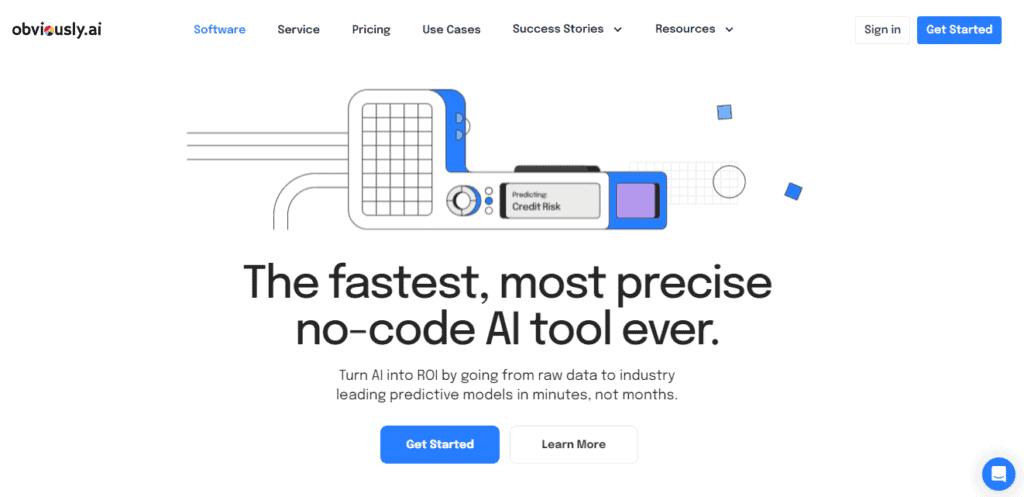
Obviously.ai offers a powerful no-code AI platform that makes it easy to generate predictive models from your data in minutes. This tool enables users without coding skills to unlock deep insights from their data.
With just a few clicks, you can build models for various predictive tasks like forecasting customer churn, lead conversion rates, loan repayment risk, and more. The platform handles complex processes like classification and regression behind the scenes to output accurate predictions.
Beyond predictive modeling, Obviously.ai provides easy model deployment, monitoring, and integration. You can put models into production instantly without DevOps hustle. Automations with Zapier allow you to trigger actions based on model predictions. Integration with BI tools like PowerBI enables data visualization on top of AI predictions.
The platform offers more than just self-service capabilities. Users get 24/7 access to a dedicated data scientist for help with data preparation, statistical analysis, and expert guidance on advanced techniques.
For any business looking to tap into the power of AI predictive analytics, Obviously.ai provides an intuitive platform to generate rapid insights from data. With minimal manual effort, Anyone can go from raw data to optimized AI models and impactful business intelligence.
It’s also worth mentioning that the company has received a seed round of $4.7M.
5. Google Teachable Machine
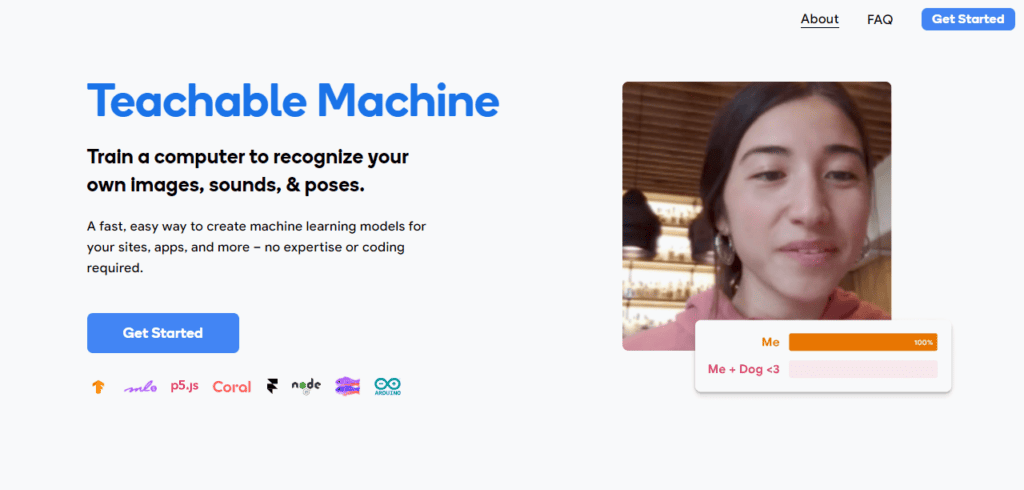
Google Teachable Machine is a web tool developed by Google Creative Lab that makes it fast and easy to create machine learning models for your projects, with no coding required.
Basically, it allows users to train a computer to recognize their own images, sounds, and poses, then export the model for use in sites, apps, and more.
It is built using the TensorFlow.js library, and there is a boilerplate version of the project that can be used as a starting point for your own projects.
This tool is great for anyone who wants to learn about machine learning and computer vision, including educators, students, and individuals. It’s a fun and easy way to get started with machine learning.
6. Microsoft Lobe

Microsoft Lobe enables anyone to build image recognition machine learning models, with no programming or data science background required.
Lobe adopts a straightforward visual approach to model training. Users simply feed it example images representing different visual classes. Behind the scenes, Lobe handles turning these examples into an optimized ML model.
The drag-and-drop interface makes the process intuitive and engaging. Within minutes, you can have a custom model trained to recognize categories relevant to your needs.
While great for beginners, Lobe is also a powerful tool for developers. The models can be exported to integrate into apps and websites across various platforms.
By democratizing access to machine learning, Microsoft Lobe opens up new possibilities. Students can gain hands-on ML experience while developers can more easily deploy AI capabilities. With its simplicity and customizability, Lobe puts ML model creation within anyone’s reach.
7. Cogniflow

Cogniflow lets you easily create artificial intelligence models from text, image, or audio, all without writing a single line of code. You can start right away by using a model already trained, what we call a public experiment. You can do sentiment analysis on customer reviews, extract information from any text or image, transcribe audio, and many more.
One of the standout features of Cogniflow is its ability to train AI models based on your specific needs. For example, if you work in customer support and want to automatically classify the intent of your customer interactions, you can use Cogniflow to train an AI model using data from previous interactions. All you need is a spreadsheet of data, and Cogniflow takes care of the rest.
Cogniflow isn’t just for text data, though. If you’re a doctor and want to automatically classify X-ray images to prioritize your patients, you can use Cogniflow to create an image experiment. You simply upload images organized by folders, with each folder representing a category or classification, and Cogniflow does the rest.
Another exciting feature of Cogniflow is its ability to create a question-answering system. If you have documentation about your company’s services and want to provide a better way for your customers to search for information, Cogniflow can help. You upload your documents, and Cogniflow creates a model that can answer open questions and tell you where that information is located.
8. Akkio
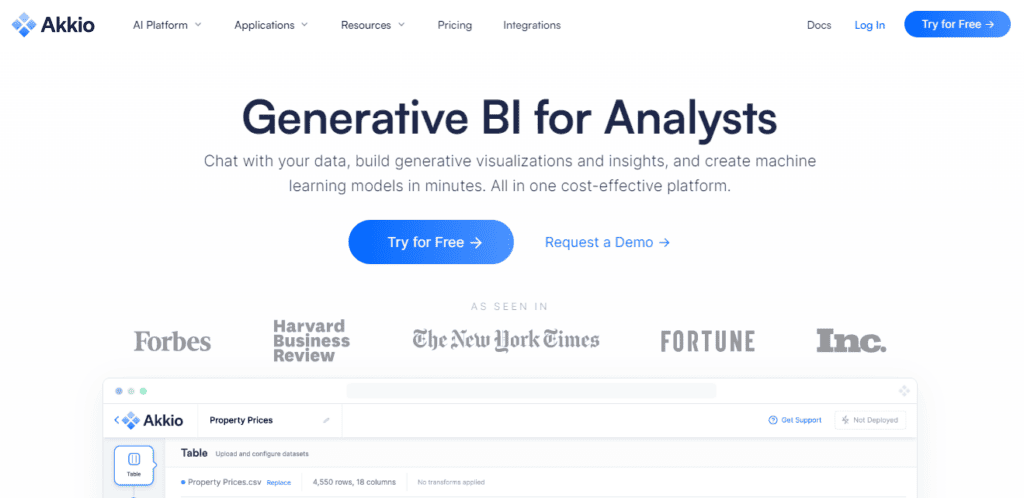
Akkio is a no-code AI platform that enables businesses to build and deploy AI with their data without coding.
The platform is designed to boost productivity, speed, and efficiency with an analytics platform powered by generative AI. This means Akkio can help you get rapid insights and make visionary predictions that can give your business a competitive edge.
Akkio is versatile and user-friendly. It can be used to automate workflow processes for non-technical knowledge workers, and it can extract, classify, generate, or summarize pieces of text. Whether you’re working with images, documents, or text, Akkio can help you supercharge your productivity.
But that’s not all. Akkio also provides a no-code AutoML solution that allows non-tech professionals to build and deploy multiple AI for various tasks like churn reduction, attrition prediction, and fraud detection.
For example, you can use it to predict the time-to-close for sales leads and prioritize which opportunities to pursue. You can also use it to predict the likelihood of customer renewal, and even predict which deals will be the most lucrative.
9. Nanonets
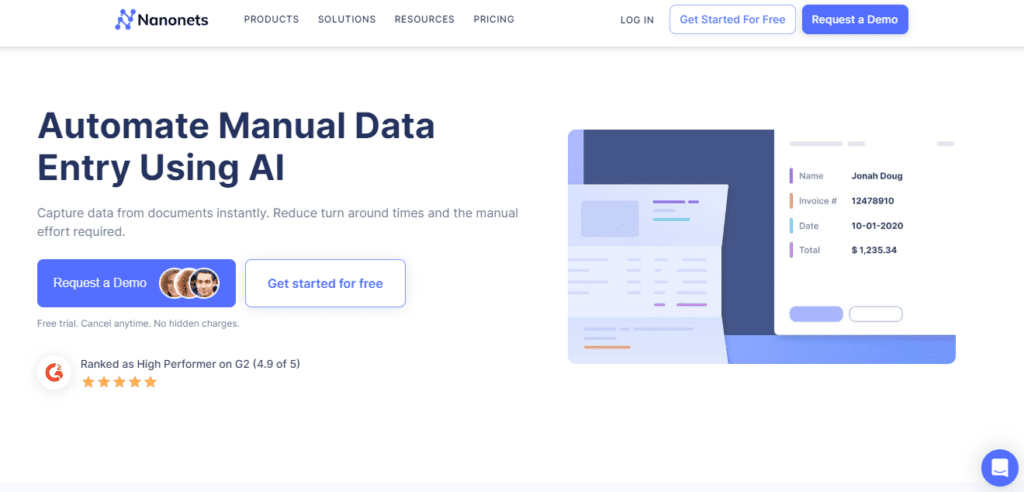
Nanonets AI platform allows users to build deep learning models for media companies, e-commerce, multi-label classification, and intelligent document processing.
Nanonets is designed to make your life easier by automating the process of extracting data from documents. If your business spends a lot of time and resources on importing data from forms, text documents, and similar sources, Nanonets could be the solution you’ve been looking for.
Nanonets uses machine learning to pull out structured or semi-structured data from documents. This could be anything from names and addresses on forms to specific pieces of information in text documents.
NanoNets has also been used to create machine learning models for a variety of applications, including object detection, image classification, content moderation, and others.
Furthermore, NanoNets can be used in conjunction with drones to develop custom deep learning models for detecting a variety of objects in images captured by drones with limited data and machine learning knowledge.
10. Levity.ai
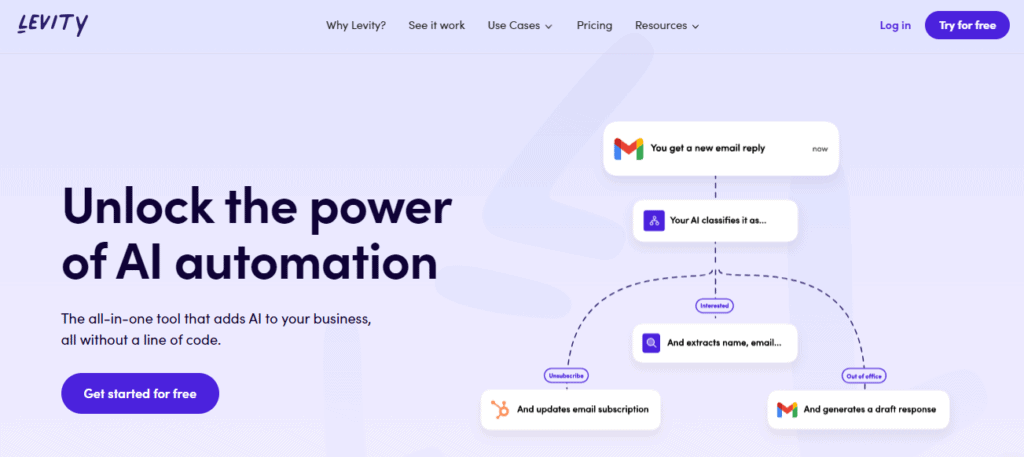
Levity is a no-code AI tool to automate workflow processes that specializes in classifying images, text, and documents, allowing users to train custom models based on their specific needs.
One of the unique features of Levity is its Human-in-the-Loop option. This means that the model can ask for input when it’s unsure about something, and it will automatically learn from these interactions.
But Levity is more than just a classification tool. It’s an end-to-end solution that integrates with all the tools you use on a daily basis. This means you can seamlessly incorporate Levity into your workflow, making it easier to manage and analyze your data.
11. Amazon SageMaker

Amazon SageMaker is a comprehensive machine learning service provided by Amazon Web Services (AWS) that equips you with the tools to build, train, and deploy machine learning models for predictive analytics applications.
SageMaker takes care of the heavy lifting involved in setting up a production-ready artificial intelligence pipeline. Basically, it simplifies the process of machine learning modeling into three easy steps: preparation, training, and deployment. This means you can focus on the important stuff, like improving your models and getting results, instead of worrying about the technical details.
SageMaker operates in the Amazon Elastic Compute Cloud (EC2), providing a fully managed machine learning instance. It also supports the open-source Jupyter Notebook web application, which allows developers to share live code. This means you can easily access data sources for exploration and analysis without having to manage servers.
One of the standout features of SageMaker is the Autopilot feature, which automates machine learning tasks, making the machine learning experience even simpler.
SageMaker is also versatile. It supports leading machine learning frameworks, toolkits, and programming languages, and allows users to customize foundation models using a complete set of machine learning tools.
This includes Amazon SageMaker Experiments, which lets you test different models, and Amazon SageMaker Pipelines, which allows you to create, automate, and manage end-to-end machine learning workflows at scale.
AI No Code Tools Wrapping Up
So as you can see, the world of AI is no longer exclusive to those with extensive coding knowledge or large teams of data scientists. The rise of no-code AI tools enables businesses of all sizes and individuals from various backgrounds to harness the power of AI.
So, whether you have an idea for your AI business or want to implement it in your exsiting business or start, there’s never been a better time to explore the power of AI. With these no-code AI tools, the future of AI is not just accessible, but it’s also in your hands.
Patryk Miszczak



